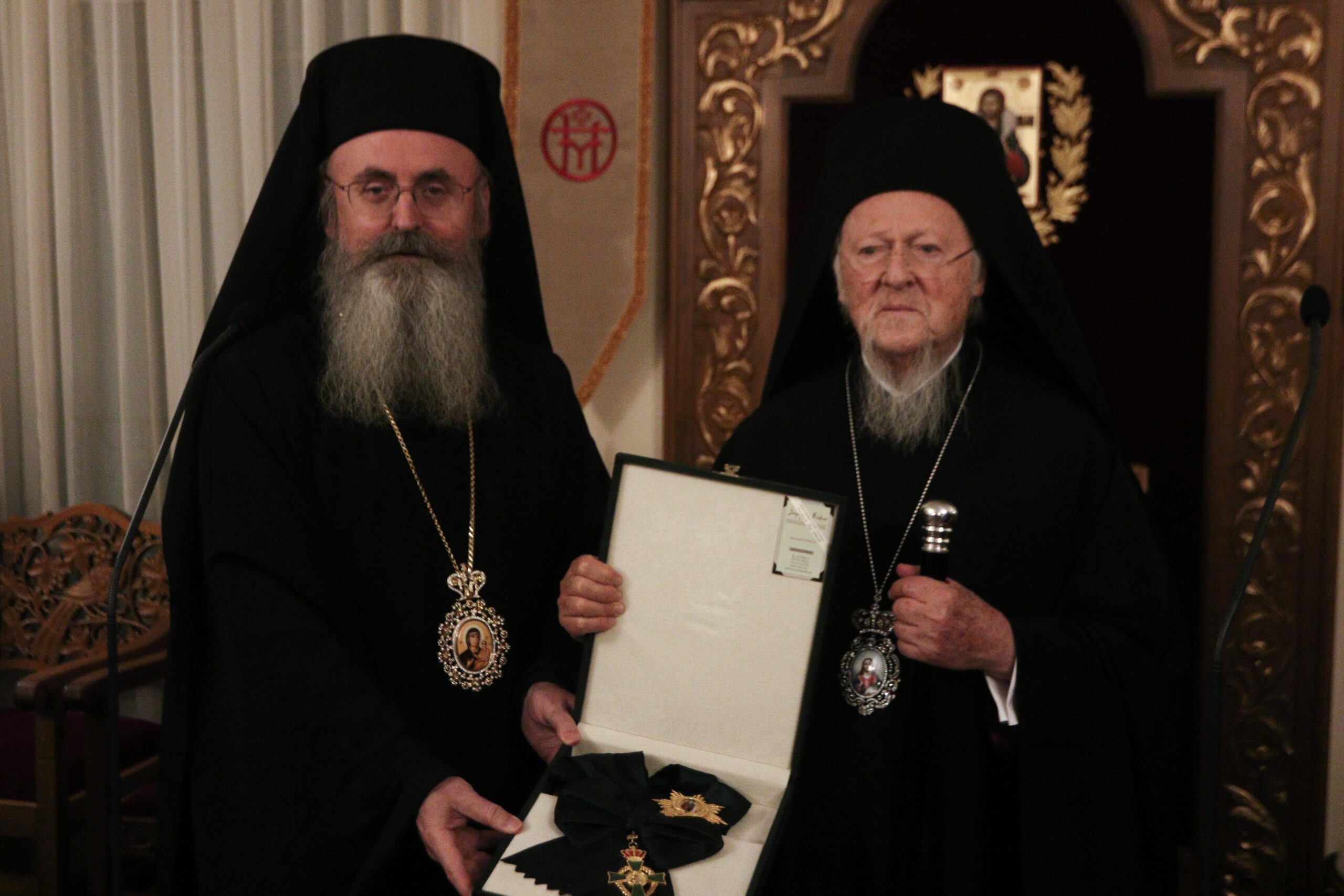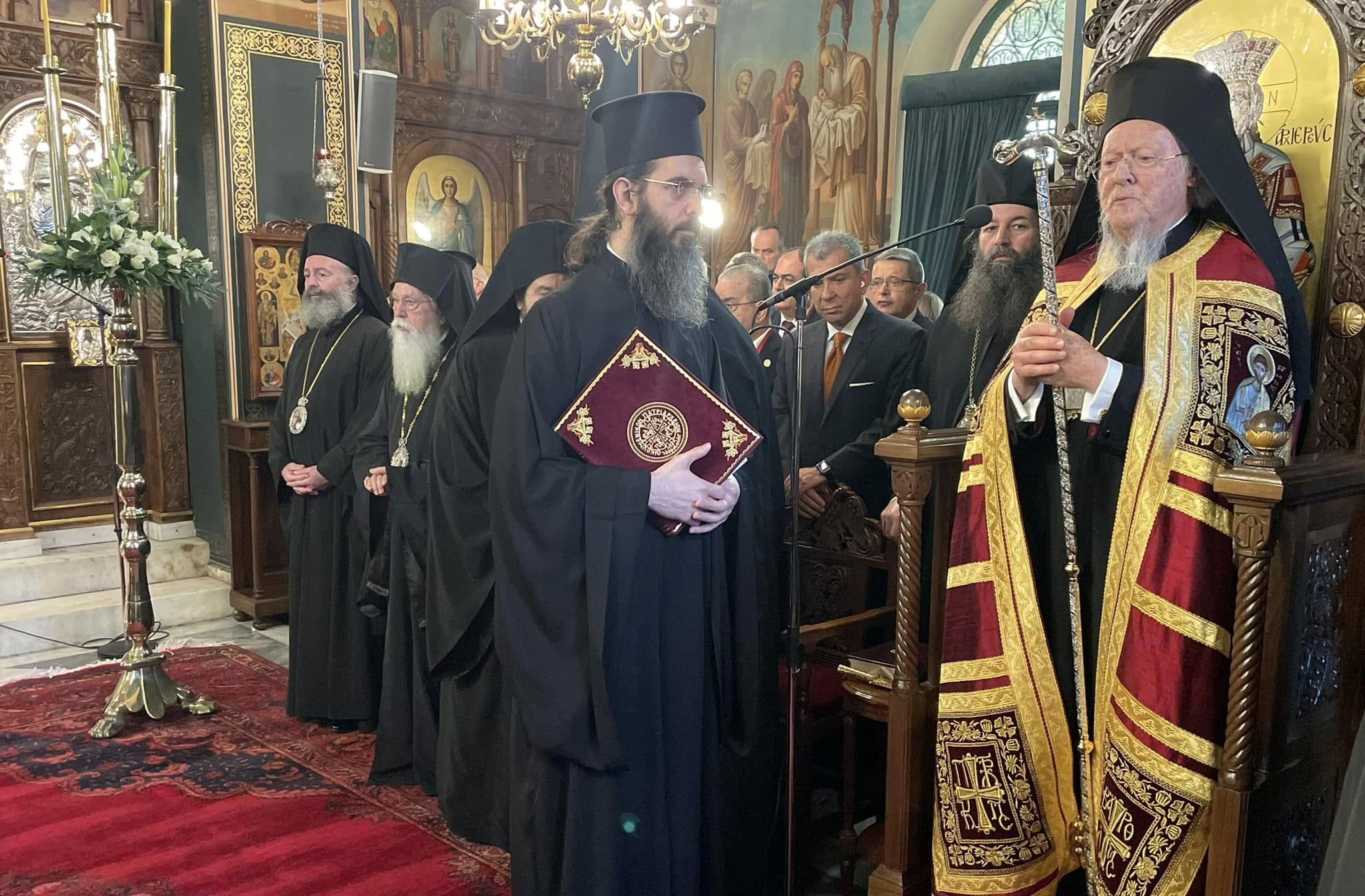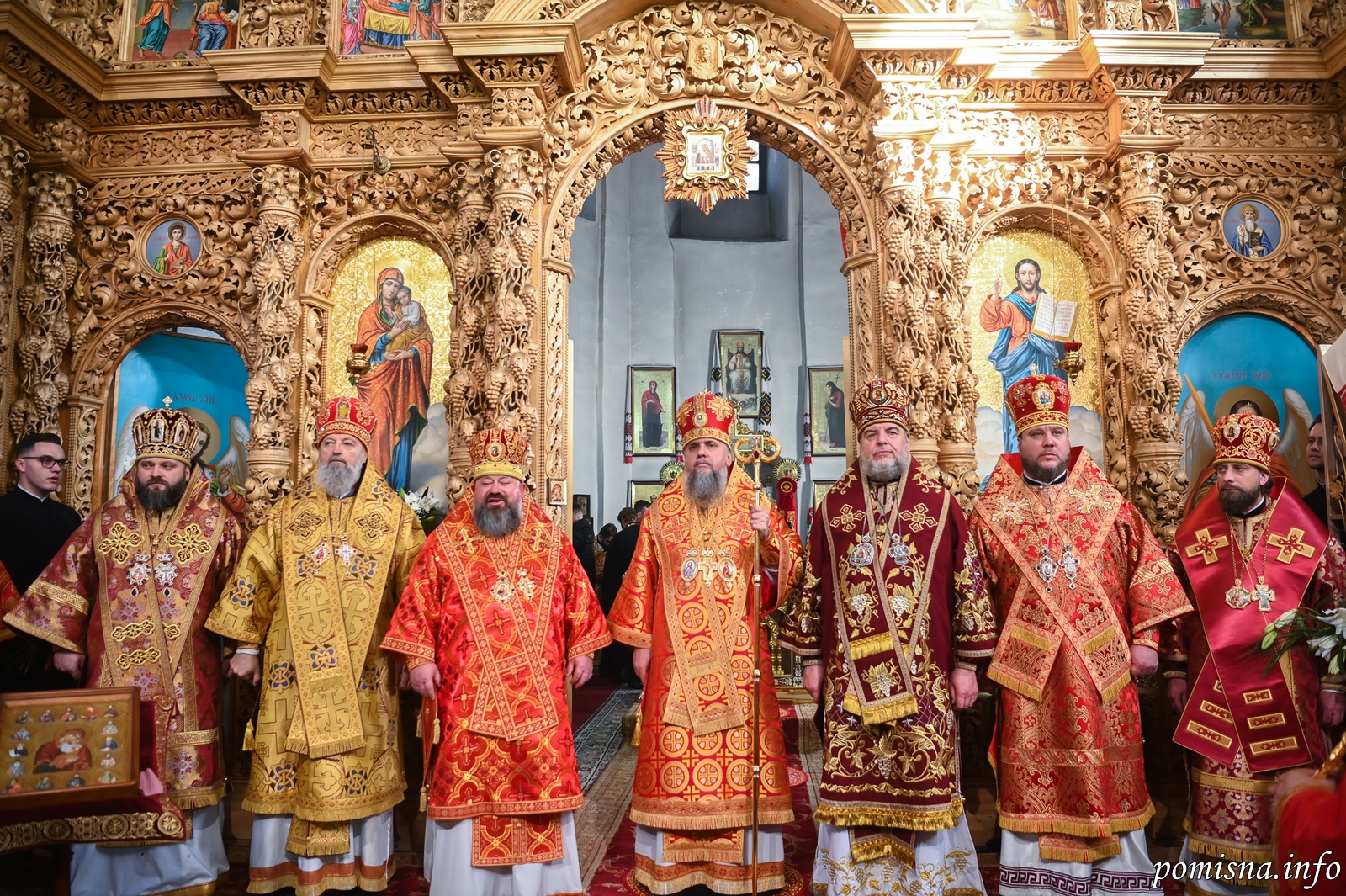Great Martyr Catherine of Alexandria (25 November)
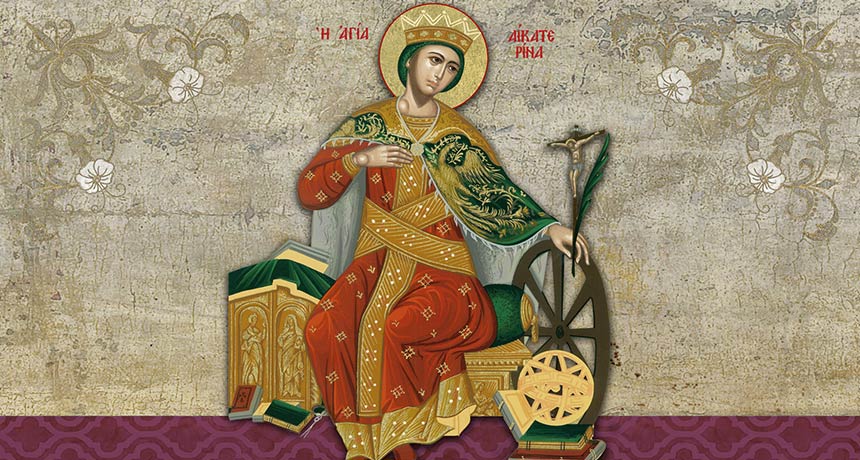

Catherine was the daughter of King Constus. After the death of her father, she lived with her mother in Alexandria. Her mother was secretly a Christian who, through her spiritual father, brought Catherine to the Christian Faith. In a vision, St. Catherine received a ring from the Lord Jesus Himself as a sign of her betrothal to Him. This ring remains on her finger even today. Catherine was greatly gifted by God and was well educated in Greek philosophy, medicine, rhetoric and logic. In addition to that, she was of unusual physical beauty. When the iniquitous Emperor Maxentius offered sacrifices to the idols and ordered others to do the same, Catherine boldly confronted the emperor and denounced his idolatrous errors.
The emperor, seeing that she was greater than he in wisdom and knowledge, summoned fifty of his wisest men to debate with her on matters of faith and to put her to shame. Catherine outwitted and shamed them. In a rage, the emperor ordered all fifty of those men burned. By St. Catherine’s prayers, all fifty confessed the name of Christ and declared themselves Christians before their execution. After Catherine had been put in prison, she converted the emperor’s commander, Porphyrius, and two hundred soldiers to the true Faith, as well as Empress Augusta-Vasilissa herself.
They all suffered for Christ. During the torture of St. Catherine, an angel of God came to her and destroyed the wheel on which the holy virgin was being tortured. Afterward, the Lord Jesus Christ Himself appeared to her and comforted her. After many tortures, Catherine was beheaded at the age of eighteen, on November 24, 310 A.D. Milk, instead of blood, flowed from her body. Her miracle-working relics repose on Mount Sinai.
The Holy Great Martyr Katherine was the daughter of Konstos, the governor of Alexandria, Egypt during the reign of Emperor Maximian (305-313). Living in the capital, the center of Hellenistic knowledge, and possessed of a rare beauty and intellect, Katherine received an excellent education, studying the works of the greatest philosophers and teachers of antiquity. Young men from the most worthy families of the empire sought the hand of the beautiful Katherine, but she was not interested in any of them. She told her parents that she would enter into marriage only with someone who surpassed her in nobility, wealth, comeliness and wisdom.
Katherine’s mother, a secret Christian, sent her to her own Spiritual Father, a saintly Elder living in a cave outside the city, for advice. After listening to Katherine, the Elder said that he knew of someone who surpassed her in everything. “His countenance is more radiant than the shining of the sun, and all of creation is governed by His wisdom. His riches are given to all the nations of the world, yet they never diminish. His compassion is unequaled.”
This description of the Heavenly Bridegroom produced an ardent desire in the soul of the holy maiden to see Him. “If you do as I tell you,” said the monk, “you will gaze upon the countenance of this illustrious man.” In parting, the Elder gave Katherine an icon of the Theotokos with the Divine Child on Her arm and told her to pray with faith to the Queen of Heaven, the Mother of the Heavenly Bridegroom, and she would hear Katherine and grant her heart’s desire.
Katherine prayed all night and was permitted to see the Most Holy Virgin, Who said to her Divine Son, “Behold Thy handmaiden Katherine, how fair and virtuous she is.” But the Child turned His face away from her saying, “No, she is ugly and unbelieving. She is a foolish pauper, and I cannot bear to look at her until she forsakes her impiety.”
Katherine returned again to the Elder deeply saddened, and told him what she had seen in the dream. He received her, instructed her in the faith of Christ, admonished her to preserve her purity and integrity and to pray unceasingly. She then received the Mystery of Holy Baptism from him. Again Saint Katherine had a vision of the Most Holy Theotokos with her Child. Now the Lord looked at her tenderly and gave her a beautiful ring, a wondrous token of her betrothal to the Heavenly Bridegroom (this ring is still on her hand).
At that time Emperor Maximian was in Alexandria for a pagan festival. Therefore, the celebration was especially splendid and crowded. The cries of the sacrificial animals, the smoke and the smell of the sacrifices, the endless blaze of fires, and the bustling crowds at the arenas defiled the city of Alexandria. Human victims also were brought, the confessors of Christ, who would not deny Him under torture. They were condemned to death in the fire. Katherine’s love for the Christian martyrs, and her fervent desire to ease their sufferings, compelled her to speak to the pagan priest and to Emperor Maximian.
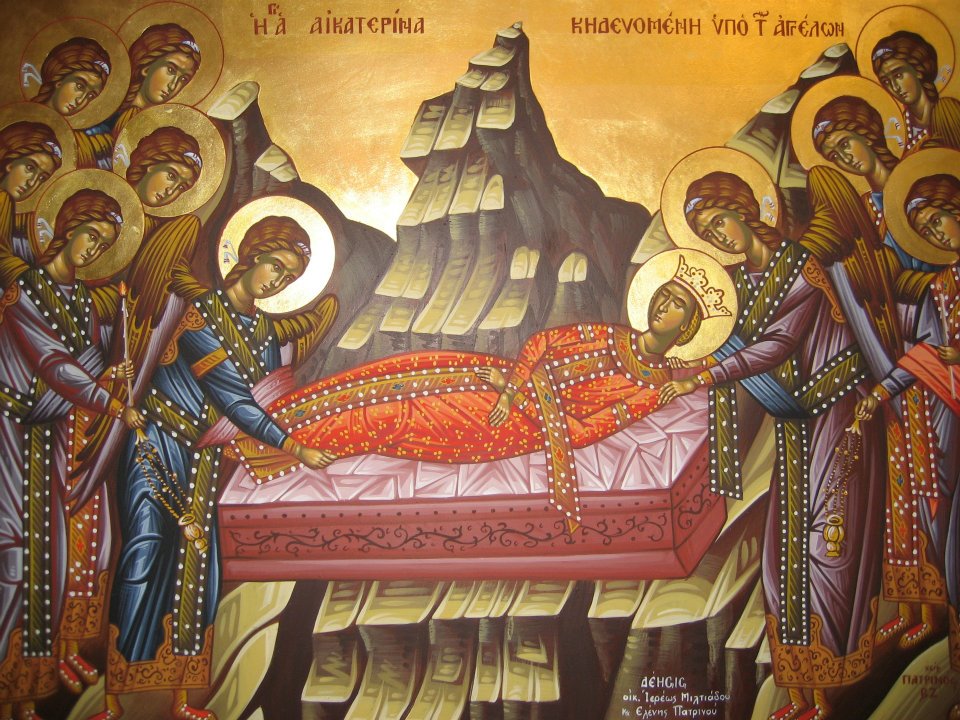

Introducing herself, the Saint confessed her faith in the One True God, and exposed the errors of the pagans. The beauty of the maiden captivated the Emperor. In order to convince her of the superiority of pagan wisdom, the Emperor ordered fifty of the most learned philosophers and rhetoricians of the Empire to dispute with her, but the Saint got the better of the wise men, so that they came to believe in Christ themselves. Saint Katherine made the Sign of the Cross over the martyrs, and they bravely accepted death for Christ and were burnt alive by order of the Emperor.
Unable to persuade the Saint, Maximian tried to entice her with the promise of riches and fame. Hearing her angry refusal, the Emperor ordered his men to subject the Saint to terrible tortures, and then throw her in prison. The Empress Augusta, who had heard much about the Saint, wanted to see her. She prevailed upon the military commander Porphyrios to accompany her to the prison with a detachment of soldiers. The Empress was impressed by Katherine’s strong spirit, and her face was radiant with divine grace. The holy martyr explained the Christian Faith to them, and they were converted to Christ.
On the following day, they again brought the martyr to the judgment court where, under the threat of being broken on the wheel, she was urged to renounce the Christian Faith and to offer sacrifice to the “gods.” The Saint steadfastly confessed Christ and she was taken to be tortured on four wheels with sharp iron spikes, but an Angel smashed the instruments of execution, which shattered into pieces with many pagans standing nearby.
After seeing this miracle, the Empress Augusta and the imperial courtier Porphyrios and 200 soldiers confessed their faith in Christ before everyone, and they were beheaded. Maximian tried again to entice the holy martyr, offering to marry her, and again he was refused. Saint Katherine remained faithful to her heavenly Bridegroom Christ, and after praying to Him, she laid her head on the block beneath the executioner’s sword.
The relics of Saint Katherine were taken by the Angels to Mount Sinai. In the VI century, the venerable head and left hand of the holy martyr were found through a revelation and transferred with honor to the newly-constructed church of the Monastery on Mount Sinai, built by the holy Emperor Justinian (November 14).
Saint Katherine is called upon for relief and assistance during a difficult childbirth. Pilgrims to her monastery on Mount Sinai are given souvenir rings as a remembrance of their visit.
Saint Katherine is commemorated on November 25 in Greek usage.
Saint Catherine, who was from Alexandria, was the daughter of Constas (or Cestus). She was an exceedingly beautiful maiden, most chaste, and illustrious in wealth, lineage, and learning. By her steadfast understanding, she utterly vanquished the passionate and unbridled soul of Maximinus, the tyrant of Alexandria; and by her eloquence, she stopped the mouths of the so-called philosophers who had been gathered to dispute with her. She was crowned with the crown of martyrdom in the year 305. Her holy relics were taken by Angels to the holy mountain of Sinai, where they were discovered many years later; the famous monastery of Saint Catherine was originally dedicated to the Holy Transfiguration of the Lord and the Burning Bush, but later was dedicated to Saint Catherine. According to the ancient usage, Saints Catherine and Mercurius were celebrated on the 24th of this month, whereas the holy Hieromartyrs Clement of Rome and Peter of Alexandria were celebrated on the 25th. The dates of the feasts of these Saints were interchanged at the request of the Church and Monastery of Mount Sinai, so that the festival of Saint Catherine, their patron, might be celebrated more festively together with the Apodosis of the Feast of the Entry of the Theotokos. The Slavic Churches, however, commemorate these Saints on their original dates.
Apolytikion of Great Martyr Catherine
Plagal of the First Tone
Let us praise the most auspicious bride of Christ, the divine Katherine, protectress of Sinai, our aid and our help. For, she brilliantly silenced the eloquence of the impious by the sword of the spirit, and now, crowned as a martyr, she asks great mercy for all.
Kontakion of Great Martyr Catherine
Second Tone
O friends of martyrs, now divinely raise up a renewed chorus, praising the all-wise Katherine. For, she proclaimed Christ in the arena, trampled on the serpent, and spat upon the knowledge of the orators.
Source: oca.org / goarch.org / westserbdio.org

